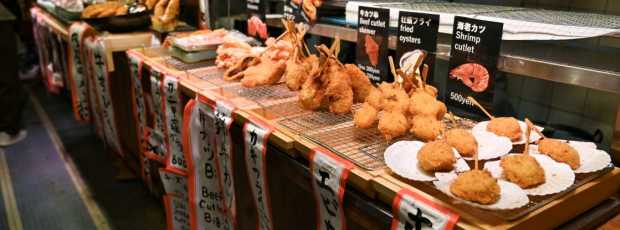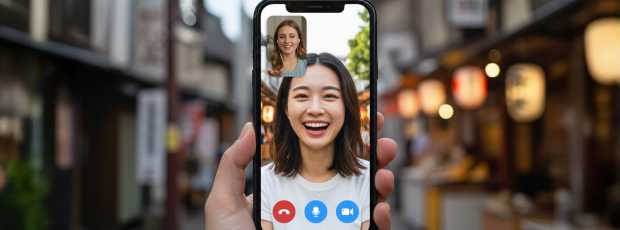Kiyoto was an amazing guide! We are very pleased with how much we were able to see and learn on our tour. Our guide was incredibly accommodating and easy going. We would highly recommend him to anyone considering a trip to Kyoto.Katie, Kyoto, 2025
Table Of Contents
- Kyoto Without the Crowds
- The Temple Trail Everyone Takes (And Why I Skip It)
- Where to Go in Kyoto That Isn't a Temple?
- Northern Kyoto Is Where I Go to Breathe
- Culture Beyond Shrines: Kyoto's Living Traditions
- Hidden Gems That Even Locals Overlook
- Getting Around Like a Local: Transportation Beyond the Tourist Routes
- Where Modern Kyoto City Meets Ancient Traditions
- Nature, But Not the Obvious Kind
- Planning Tip: Skip the Temple Fatigue
- Planning Your Non-Temple Kyoto Experience
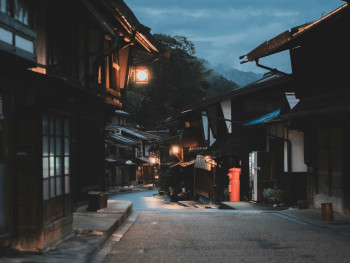
Early morning in a quiet Kyoto alley with traditional wooden townhouses and no people around. Image by Quentin Touvard on Unsplash.
Kyoto Without the Crowds
Look, I get it. You’ve seen the photos of Fushimi Inari’s thousand torii gates, heard about Kinkaku-ji’s golden pavilion, and maybe even practiced saying "Kiyomizu-dera" without butchering it completely. Kyoto’s temples are stunning, no question. But here’s what your guidebook won’t tell you. They’re not the whole story.
I’ve lived in this city for thirty-two years, and I can count on one hand how often I’ve voluntarily visited a temple in the past decade. Not because I don’t appreciate them, but because Kyoto is so much more than its spiritual landmarks. When I wake up on a Saturday and think about things to do in Kyoto besides temples, I think of places that show how this city lives and breathes.
Discovering Authentic Things to Do in Kyoto Besides Temples
The truth is, most temple visits feel like checking boxes. You shuffle through with the crowd, snap the required photos, and leave thinking you’ve “done” Kyoto without actually getting to know it.
Meanwhile, the real city, the one I walk through every day, hums quietly just beyond those gates.
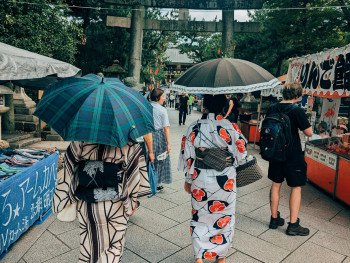
People explore and shop at a lively morning market in Kyoto filled with fresh produce and local goods. Image by NoteThanun on Unsplash.
This morning, I watched a businessman grab his usual takoyaki from the stand he’s visited for fifteen years. Three blocks away, tourists were lining up at 6 AM for temple photos. Which one felt more like Kyoto to me?
Local Kyoto vs. Tourist Kyoto
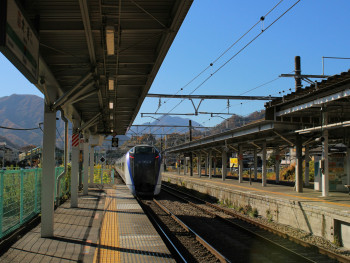
A train arrives at a calm, nearly empty platform in a Kyoto station during a quiet moment of the day. Image by Dhruv Patel on Unsplash.
I'm not here to bash temple tourism. If that's your thing, go for it. Kyoto has seventeen UNESCO World Heritage Sites, and they earned that status for good reason. Kinkaku-ji (the Golden Pavilion) and Kiyomizu-dera are architectural marvels worth seeing. Fushimi Inari Shrine, with its thousands of vermilion torii gates, delivers a surreal experience you won't find anywhere else.
Why Kyoto's UNESCO Sites Aren't the Whole Story
If you're tired of battling crowds for the perfect Instagram shot, or if you're curious about what really makes Kyoto tick beyond its historic facades, stick around. I'm going to show you the city I actually live in, the one that exists in the spaces between the UNESCO World Heritage Site markers.
The Temple Trail Everyone Takes (And Why I Skip It)
Before I tell you about Kyoto attractions that don't involve shrine hopping, let me acknowledge what you're probably skipping. Central Kyoto draws millions of visitors each year to its ancient temples and UNESCO World Heritage Sites.
The Golden Pavilion reflects perfectly in its pond. Ginkaku-ji (the Silver Pavilion) showcases refined aesthetic principles, and Yasaka Shrine connects seamlessly to the historic geisha district of Gion.
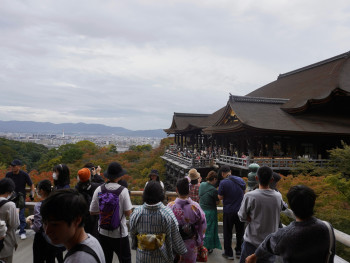
Crowds of tourists queue early in the morning to enter a well-known temple in Kyoto, Japan. Image by Hahaha A on Unsplash.
These sites represent traditional Kyoto at its most iconic. Nanzen-ji temple holds the status as one of Japan’s most important Zen Buddhist temple complexes. The main hall of Kiyomizu-dera temple offers panoramic views across Kyoto city. And the Philosopher's Path connects several of these landmarks, winding past cherry trees that bloom into tunnel-like canopies each spring.
Popular Kyoto Attractions on Every Tourist's List
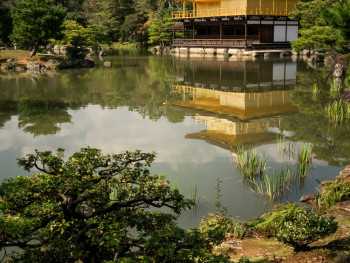
The iconic Golden Pavilion shines bright as it reflects clearly in the calm pond surrounding the temple in Kyoto. Image by Svetlana Gumerova on Unsplash.
But here's what happens when you follow the standard temple circuit in Kyoto. You see what everyone else sees, jostle for the same photos, and leave feeling like you completed an assignment instead of discovering a place. The ancient capital turns into a checklist, not an experience.
Kyoto Beyond the Guidebooks: Finding Contemporary Culture
Kyoto prefecture contains over 2,000 temples and shrines. Yet most visitors focus on the same dozen or so popular spots that appear in every guidebook.
Meanwhile, the city's contemporary culture, the part that makes Kyoto a living place rather than an open-air museum, keeps evolving just beyond those temple gates.
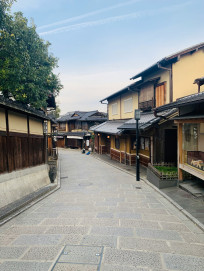
A peaceful residential street in Kyoto with traditional wooden houses alongside modern buildings under soft daylight. Image by Shirley Wang on Unsplash.
Kyoto Your Way: Real Moments, Local Connections
Skip the tours. These private Kyoto experiences are flexible, personal, and built entirely around what you want to see and do.
Where to Go in Kyoto That Isn't a Temple?
When people ask me about things to do in Kyoto that aren't temples, I usually start with a simple question. What do you enjoy doing at home? Odds are, Kyoto has a version of it that’s more interesting, more layered, and maybe even a little surprising.
Kyoto International Manga Museum: Where Culture Meets Comics
Take the Kyoto International Manga Museum, for instance. This isn't some dusty academic institution. It's a converted elementary school that houses over 300,000 manga volumes. You can spend hours here reading everything from classic Osamu Tezuka works to contemporary series you’ve never heard of.
The building itself tells a story about how Kyoto adapts old spaces for new purposes. That kind of reinvention happens constantly in this city.
I brought my nephew here last month, expecting to stay for an hour. Three hours later, I was deep into a 1970s baseball manga while he devoured the latest Shonen Jump releases. The museum also hosts workshops where you can try your hand at manga creation. That kind of interaction connects you to contemporary Japanese culture in a way temple visits simply can’t.
Then there’s Nishiki Market, which locals call "Kyoto's kitchen." This narrow shopping street stretches for five blocks through central Kyoto, offering food experiences that connect you to Japanese culture in immediate, tangible ways.
Yes, it's touristy now. But go early in the morning or late in the afternoon, and you'll catch it in its working rhythm.
This isn’t just about sampling street food (though you should definitely try the tofu dengaku and matcha tea ice cream). It’s about watching a 400-year-old market adapt to modern appetites while keeping its essential character.
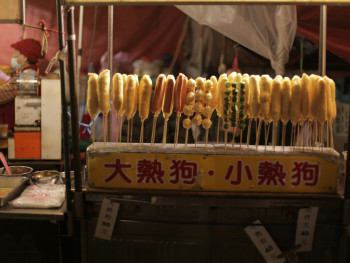
A vendor carefully arranges skewers of food at a busy stall in Nishiki Market, Kyoto’s famous food market. Image by MChe Lee on Unsplash.
Nishiki Market and Kyoto’s Culinary Culture
The vendors here aren't performing for tourists. They're feeding a city. Mrs. Tanaka, who runs the pickle stand three shops down from the main entrance, has been perfecting her tsukemono recipes for forty years. She’ll tell you exactly which vegetables are in season and how to pair different pickles with various dishes. That kind of exchange teaches you more about Japanese culture than any brochure.
Nishiki Market connects to a network of covered shopping streets that stretch through central Kyoto. These hidden gems are packed with traditional craft shops, tea sellers, knife makers, and the occasional gallery. You’ll find businesses that have served locals for generations, alongside new shops that reflect changing tastes.
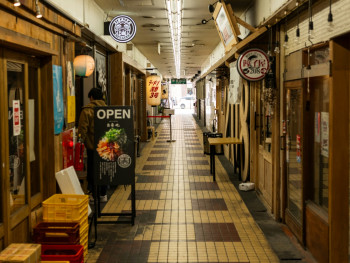
A covered shopping street in central Kyoto featuring a mix of traditional and modern shops under a bright canopy.. Image by Kouji Tsuru on Unsplash.
You could spend hours weaving through these alleys. They’re lively, local, and full of surprises. Exactly what you came to Kyoto for, even if you didn’t know it yet.
Kyoto Botanical Gardens: Green Space Without the Crowds
Kyoto Botanical Gardens offers a different kind of escape. While everyone's cramming into temple gardens, these 24 hectares give you space to breathe. The conservatory houses tropical plants from around the world, but the native plant sections are the real standout. They show you what Kyoto looked like before human hands shaped every inch of it.

A peaceful, shaded path winds through lush greenery inside Kyoto Botanical Gardens on a calm day. Image by Kouji Tsuru on Unsplash.
The gardens shift with the seasons. Spring brings cherry blossoms without the chaos of Maruyama Park. Summer features evening illuminations that turn the grounds magical. In autumn, the maples are just as vivid as those in temple courtyards. And winter? It’s quiet, clean, and strangely peaceful. A perfect counterpoint to the city’s colder months.
Kyoto Station: The City Within a City
Most people rush through Kyoto Station without looking around. But architect Hiroshi Hara designed it as much more than a transit hub. It’s a vertical city.
The building houses shopping centers, restaurants, a hotel, event halls, and art installations spread across multiple levels. You can have lunch overlooking the city, wander through a bookstore, and be eating ramen in a basement stall an hour later. You could spend half a day here and not run out of things to do. And never once need to scan a temple ticket.
Green Spaces and Seasonal Escapes in Kyoto
Nijo Castle shows a different side of Kyoto, one rooted in political power rather than spiritual authority. This former shogun's residence offers a glimpse into how Japan’s military rulers lived and governed. Its traditional wooden floors, known as “nightingale floors,” were designed to squeak when stepped on, alerting guards to intruders.
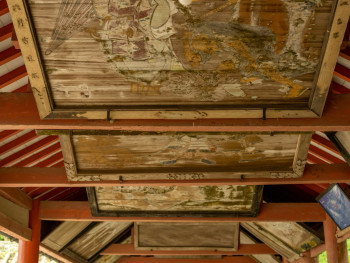
Interior corridor of Nijo Castle featuring traditional painted screens and polished wooden floors in Kyoto. Image by Kouji Tsuru on Unsplash.
The castle’s gardens shift dramatically with each season. Spring brings cherry blossoms that rival any temple display. In autumn, the maples turn brilliant shades of red and gold. Despite its beauty, Nijo Castle rarely feels overcrowded. That might be because it requires a bit more historical context to fully appreciate.
Located just a short walk from central Kyoto, Nijo Castle pairs well with other non-temple activities. Nearby, you’ll find independent tea houses offering traditional tea ceremonies in quiet, intimate settings. These spaces focus on the social and meditative aspects of green tea, not the religious rituals found in temple ceremonies.
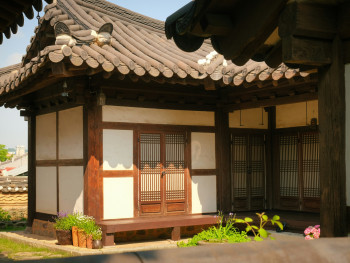
Exterior of a traditional Japanese tea house with wooden walls and a noren curtain hanging over the entrance. Image by Minku Kang on Unsplash.
The Kyoto Imperial Palace adds another layer to the city’s cultural identity. Instead of spiritual practice, this site represents Japan’s imperial history and ceremonial traditions. The palace grounds are open to the public, and the space is large enough that even during peak seasons, you can still find quiet corners to pause and take it all in.
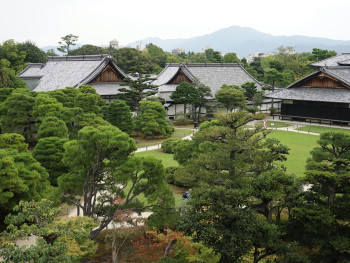
Traditional gardens of Kyoto Imperial Palace with manicured plants and distant mountain views on a clear day. Image by YQ Tian on Unsplash.
Northern Kyoto feels different from the tourist-heavy areas near the main temples. These neighborhoods grew around daily life, not pilgrimage routes.
Northern Kyoto Is Where I Go to Breathe
When I need to remember why I love this city, I head north. Northern Kyoto feels different from the tourist-heavy areas near the main temples. These neighborhoods grew around daily life, not pilgrimage routes, which gives them a more lived-in rhythm.
The Kyoto Imperial Palace anchors this area. It's not a temple, but the former residence of Japan's Imperial family. The palace grounds are free to enter and spacious enough that you can always find a quiet corner, even during peak season. Just as important is the surrounding neighborhood, which reflects how Kyoto’s elite lived and worked for centuries.
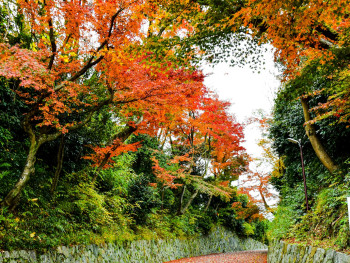
A quiet forest path winds through northern Kyoto with early autumn leaves starting to change color. Image by AXP Photography on Unsplash.
Independent Cafes and Daily Rituals in Northern Kyoto
The real magic starts when you leave the palace grounds and wander through the residential streets. This part of the city’s north side has some of the best independent cafes. Many are tucked into converted machiya (traditional wooden townhouses) or minimalist modern spaces built with care and intention.
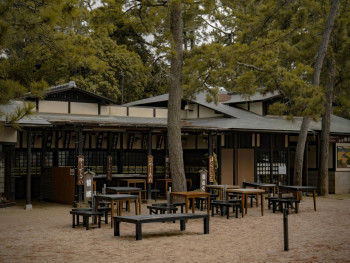
Exterior of a traditional wooden café located in northern Kyoto, blending rustic charm with local style. Image by Huu Huynh on Pexels.
These neighborhood cafés say something real about Japanese culture, the art of elevating everyday life. Every detail matters. The cup, the water temperature, the lighting, even the music volume. It’s not for show. This is how people here genuinely prefer to live.
Hiking Trails and Natural Escapes Around Mount Daimonji
The hiking trails around Mount Daimonji offer another kind of escape. Mount Daimonji, famous for its summer bonfire festival, has routes ranging from relaxed walks to full-blown workouts. These trails connect to mountain paths that circle the city.
I recommend the route that begins near Ginkaku-ji, but veers away from the temple. Within twenty minutes, you’re surrounded by forest. The city noise fades. You hear birds and wind through cedar trees. These mountains have been Kyoto’s natural edge for over a thousand years. They still offer the breathing room modern city life doesn’t.
Discover Kyoto Your Way with a Local Guide
Skip the usual and craft your perfect day in Kyoto with a local who tailors experiences to your interests and pace.
Culture Beyond Shrines: Kyoto's Living Traditions
Here's where things get interesting. Kyoto's cultural traditions didn’t stop evolving when the temples were built. The city continues to develop and refine practices that stay rooted in history while meeting contemporary needs.
Tea Ceremony Culture Beyond Temple Grounds
Tea ceremony experiences outside temple settings offer a different view of this art. Private tea schools across Kyoto city host sessions focused more on mindfulness and social connection than religious formality. I’ve attended ceremonies in modern homes, traditional tea houses, and even warehouse spaces reimagined for cultural use.
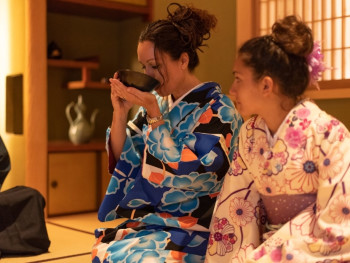
A woman dressed in a kimono carefully performs a traditional Japanese tea ceremony indoors.
The traditional tea ceremony I experienced last month took place in a machiya the owner had converted into a cultural space. The host explained each movement and gesture, but the focus was on mindfulness and social connection rather than strict ritual. We talked about seasonal poetry and even current politics between each stage. It felt like a living tradition, not a museum piece.
Independent green tea shops also provide a more grounded look at Kyoto's tea culture. These aren’t the flashy matcha selfie stops. They’re serious tea vendors working with local farms, offering tastings that teach you about grades, terroir, and brewing techniques.
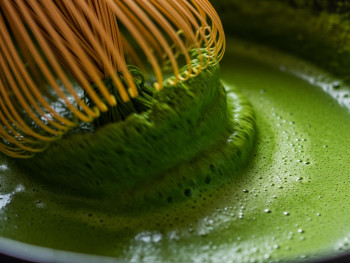
A close-up view of vibrant green matcha tea being whisked vigorously in a traditional tea bowl.
Ippodo Tea, operating since 1717, maintains a tasting room where you can sample different green tea grades and learn proper preparation techniques. The staff treat tea with the same seriousness wine experts bring to viticulture. They understand terroir, processing methods, and ideal brewing conditions. A session here teaches you more about Japanese tea culture than a dozen temple visits, and you'll come away knowing the difference between ceremonial-grade powdered green tea and the kinds used for daily drinking.
Tea houses throughout Kyoto city show how traditional Japanese culture adapts to modern life without losing its core values. Some occupy centuries-old buildings where generations of tea masters have refined their practice. Others are in modern spaces built with traditional aesthetics in mind. Both honor the cultural significance of green tea while making it approachable for today's participants.
Zen Buddhism in Everyday Kyoto Life
Zen Buddhism influences Kyoto city culture in ways that extend far beyond temple grounds. The philosophies that developed in Kyoto’s monasteries include simplicity, attention to detail, and a deep connection to nature. These ideas show up in restaurant design, residential spaces, and public planning.
These principles shape how many residents approach everyday life, from green tea preparation to garden maintenance.
You can see Zen ideas in modern contexts throughout Kyoto. The Kyoto City Museum of Art, for instance, recently reopened after a major renovation. Its architecture blends traditional Zen aesthetics with modern materials and functions.
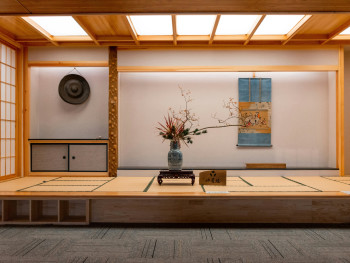
Museum interior featuring clean lines and natural materials inspired by Zen aesthetics in a modern setting. Image by Curtain Inin on Unsplash.
The result feels both grounded in heritage and relevant to contemporary life.
Meditation sessions led by lay practitioners offer another path into Zen thinking, without the structure of temple visits. These sessions focus on mindfulness and stress relief, not religious doctrine.
They’ve become popular with locals and travelers alike, especially those curious about the quieter undercurrents of Japanese culture.
Design Inspired by Zen Buddhist Temple Architecture
Kodai-ji temple shows how Zen Buddhist temple architecture influences broader design trends. You’ll find similar principles throughout Kyoto city, even in secular spaces. Contemporary architects often use clean lines, natural materials, and spatial balance first developed in temple construction to shape modern homes, shops, and public buildings.
Hidden Gems That Even Locals Overlook
Kyoto city contains countless hidden gems that never make it into standard guidebooks, yet offer authentic experiences of Japanese culture. These places may not have the fame of UNESCO World Heritage Site locations, but they reveal how traditional Japanese culture continues to evolve in a modern context.
Lesser-Known Temples That Still Shine
Eikando temple shows how ancient sites can remain spiritually relevant while adapting to modern visitors. Unlike Kyoto’s more crowded temples, Eikando offers a quieter encounter with Zen Buddhist temple architecture and philosophy. Its autumn illuminations are among Kyoto city's most spectacular seasonal displays, yet many tourists miss this hidden gem.
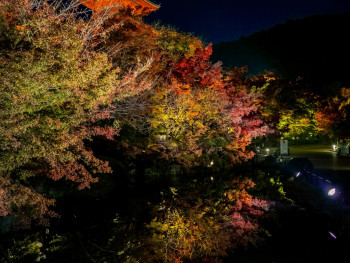
Eikando temple’s famous maple trees illuminated in vibrant autumn colors during a night viewing in Kyoto. Image by Yanghong Yu on Unsplash.
Kodaiji temple is another example of thoughtful balance between preservation and access. Its serene gardens blend traditional and modern design, while the main hall features notable works of Japanese art from various historical periods. At night, Kodaiji's illuminated grounds transform into a soft interplay of light and shadow that few expect.
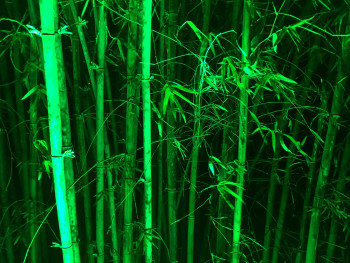
Bamboo grove at Kodaiji temple glowing with soft lights during a peaceful nighttime illumination in Kyoto. Image by Doug Ouverson on Unsplash.
Miyagawa-cho and the Quiet Side of the Geisha World
The geisha district of Miyagawa-cho offers a more intimate alternative to the crowded Gion area. This hidden gem maintains its traditional character while remaining a working neighborhood where geiko and maiko live and train. The tea houses here serve local clients rather than tourists, creating opportunities to observe traditional Japanese culture in its natural context.

A peaceful street in Miyagawa-cho geisha district lined with traditional wooden buildings and soft evening light. Image by Joris Beugels on Unsplash.
Visit Japan recommendations rarely mention the neighborhood temples scattered throughout the residential areas of Kyoto city. These smaller ji temple locations serve local communities and continue practices that connect to centuries-old traditions. Unlike the more famous Zen Buddhist temple complexes, neighborhood temples focus on community service instead of tourism.
Many of these lesser-known Ji Temple locations contain surprising artistic treasures. Japanese art collections, beautiful moss garden designs, and architectural details rival what you’ll find at major UNESCO World Heritage Site temples. The difference is accessibility. You can often arrange private visits or take part in community ceremonies that offer deep cultural insight.

A small temple surrounded by a carefully tended moss garden in a quiet neighborhood setting. Image by Esther T on Unsplash.
Neighborhood Shrines and the Soul of Kyoto
Kyoto Prefecture contains thousands of Shinto shrine locations, each dedicated to different aspects of Japanese culture and spiritual practice. While Fushimi Inari Shrine attracts millions of visitors each year, smaller shrines throughout Kyoto city offer more intimate encounters with Shinto traditions and the Shinto gods that protect local communities.
Yasaka Shrine represents one of Kyoto city's most accessible Shinto experiences. Located at the entrance to the geisha district, Yasaka demonstrates how sacred spaces coexist with everyday urban life. Its festivals throughout the year highlight traditional Japanese culture in motion, not just as preserved history.
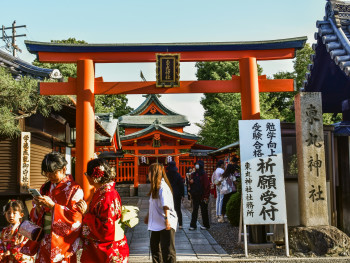
Visitors dressed in traditional kimono walk through the main gate of Yasaka Shrine in Kyoto. Image by Alex on Unsplash..
Local Shinto shrine locations often occupy sites that have been sacred for over a thousand years, predating many of the temples that attract more attention today. These shrines connect contemporary Kyoto city residents to spiritual practices that helped shape ancient Japan and still influence daily life.
The rituals performed at neighborhood Shinto shrines offer a kind of cultural access that tourist-focused temple visits rarely provide. Wedding ceremonies, seasonal festivals, and community celebrations reveal how spiritual traditions continue to adapt while holding onto what matters most.
Downtown Kyoto: Layers of the Unexpected
After three decades in this city, I still discover places that make me rethink what I thought I knew about Kyoto. The downtown area, which most tourists pass through quickly on their way to more famous destinations, contains layers of history and contemporary culture that reward careful exploration.
Downtown Kyoto doesn’t fit the image most people carry of the city. The architecture is mostly modern, the streets follow a grid laid out over a thousand years ago, and the mix of businesses reflects both historical continuity and modern adaptation. You’ll find traditional craft shops next to sleek galleries, century-old restaurants beside innovative cocktail bars.
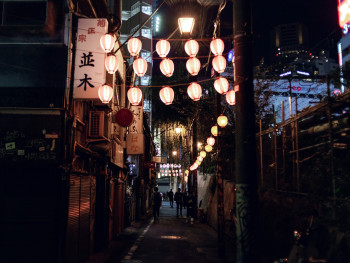
A cozy downtown Kyoto alley glowing with lanterns and lined with traditional sake bars at night. Image by Antonio Rull on Unsplash.
The Pontochō district shows this layering perfectly. By day, it’s a narrow alley lined with restaurants that feel almost out of time. At night, it transforms into something that feels both ancient and completely current. The establishments range from invitation-only kaiseki restaurants to casual izakaya, where anyone can sit down and order off a picture menu.
Artist collectives have moved into old buildings throughout downtown, repurposing spaces that once served entirely different functions. Former textile warehouses now house sculpture studios. Abandoned machiya have become performance spaces hosting everything from experimental theater to electronic music shows.
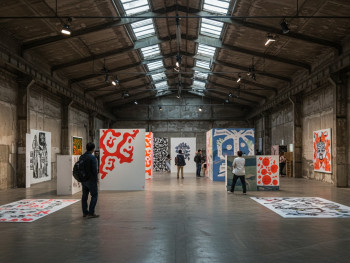
Contemporary pop-up art installation displayed inside a large, open warehouse space in Kyoto.
These spaces highlight something essential about contemporary Kyoto culture. They show the ability to adapt historical structures for new uses while respecting their original spirit. The renovations usually preserve foundational elements while updating function. The result feels both grounded and fresh.
Kyoto Station: Where Transit Meets Culture
Kyoto Station continues to surprise me with its programming. The station regularly hosts art exhibitions, musical performances, and cultural events that have nothing to do with transportation. The central atrium becomes a performance space, the connecting bridges serve as exhibition galleries, and the multiple levels offer different perspectives on the same events.
Last month, I discovered a small gallery space on the station's tenth floor that I had somehow missed in thirty years of using the building. The exhibition featured contemporary photographs of Kyoto that challenged conventional tourist imagery. Instead of golden temples and cherry blossoms, the photographer had documented the city's industrial areas, modern apartment complexes, and suburban shopping centers.
Make It Yours with Local Flexibility
City Unscripted helps you create a trip that fits your interests, pace, and style. Skip rigid tours and explore Kyoto with a local who adapts every detail to you.Getting Around Like a Local: Transportation Beyond the Tourist Routes
Most visitors to Kyoto city stick to the main tourist transport lines, but the city's rail network connects to countless hidden gems that rarely show up in guidebooks. The JR Nara Line, for example, links central Kyoto to suburbs where traditional Japanese culture still thrives, quietly and without fanfare.
Central Kyoto acts as a hub for several rail lines that can carry you far from the usual sights. Many train stations near major landmarks also serve areas that offer more authentic encounters with everyday Japanese life.
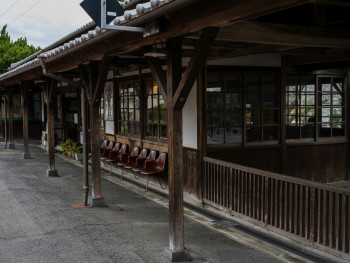
Commuters wait on a train platform featuring traditional Japanese architecture in a quiet local station. Image by Kouji Tsuru on Unsplash.
Use local transportation patterns instead of tourist shortcuts, and you'll find neighborhoods where traditional wooden houses sit next to modern apartments, where family-run shops serve regulars who’ve been coming for decades, and where seasonal festivals reflect community rhythms rather than tourist itineraries.
Riding the JR Nara Line to Hidden Kyoto
The JR Nara Line especially rewards curious travelers. Stations between Kyoto city and Nara lead to rural temples, traditional craft workshops, and farm communities that reveal what Kyoto prefecture looks like beyond the urban center. These places offer a view of traditional Japan that complements, rather than repeats, the experience at major UNESCO World Heritage Sites.
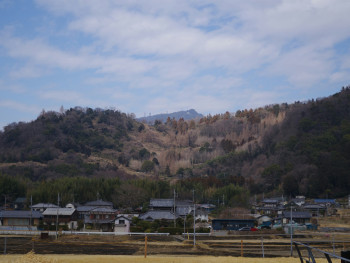
A serene rural temple complex reachable by local train, set against a backdrop of lush mountains in Kyoto prefecture.
Typical Visit Japan itineraries focus on destinations near major transport hubs. But Kyoto city's local train lines reach spots where ancient traditions have quietly adapted to modern life. These small stations serve communities that maintain cultural practices without turning them into performances.
Where Modern Kyoto City Meets Ancient Traditions
Contemporary Kyoto city shows how the former capital continues to adapt without losing its cultural core. The balance between traditional Japanese culture and modern life stands out most in neighborhoods where preservation and innovation live side by side.
Central Kyoto offers plenty of examples: modern businesses operating inside traditional wooden houses, carefully updated for everyday use. These spaces reflect a broader cultural mindset that preserves what matters while making room for practical change.
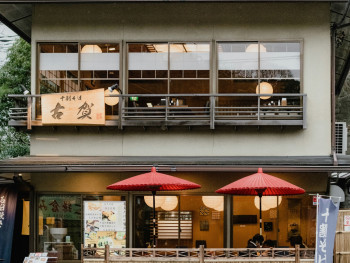
A modern café operating within a carefully renovated traditional wooden house blending old and new styles. Image by Mohamed Jamil Latrach on Unsplash.
Art, Architecture, and Kyoto’s Cultural Continuity
The integration of ancient and contemporary elements goes well beyond architectural preservation. Japanese art galleries throughout Kyoto city regularly exhibit contemporary works that engage with traditional themes and techniques. These exhibitions show how aesthetic principles from ancient Japan continue to inspire modern artistic practice.
Japanese culture today reflects centuries of gradual evolution, not abrupt shifts. When you explore Kyoto with an eye for these continuities, you start to see how the ancient capital became a modern city without losing its essence. That context makes temple visits feel more grounded and meaningful, should you choose to include them on your itinerary.
Nature, But Not the Obvious Kind
Kyoto's natural spaces extend far beyond the manicured temple gardens. The city sits in a valley bordered by mountains, offering outdoor experiences that many visitors overlook.
Kyoto’s Monkey Park: A Wild Viewpoint
Iwatayama Monkey Park offers one of the most unusual perspectives on Kyoto City. Perched on a mountainside across the river from central Kyoto, it’s accessible by a moderately challenging hike that takes about thirty minutes from the nearest train stations. The destination is worth the effort: an observation area where Japanese macaques roam freely, and the views across the entire Kyoto valley are remarkable.

A Japanese macaque monkey looks out across the Kyoto city skyline with soft evening light in the background. Image by Walter Coppola on Unsplash.
The monkey park experience differs completely from typical zoo visits. The monkeys control the space. Humans are restricted to designated areas while the macaques move freely throughout their territory. You can purchase food to feed them, but only from inside a building where wire mesh protects humans from overly enthusiastic monkeys. This monkey park arrangement reflects Japanese culture’s approach to human-animal relationships, with an emphasis on respect and clear boundaries.

Wide panoramic view of Kyoto city seen from the observation deck at Iwatayama Monkey Park during daylight. Image by Andrea Schaffer from Sydney, Australia Creative Commons Attribution 2.0
The hike itself is part of the appeal. It passes through native plant communities, giving a glimpse of what this area looked like before modern development. At the summit, the layout of Kyoto spreads out below, making the city’s relationship with its natural surroundings easy to see.
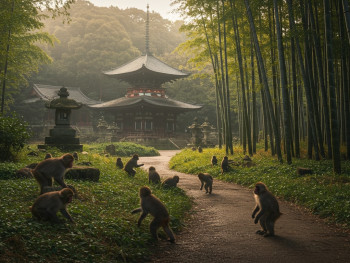
Japanese macaques playing close by with traditional temple buildings visible in the distance in Kyoto.
What makes the monkey park particularly valuable is its location outside the usual tourist circuits. You won’t encounter the crowds that swarm popular temples and UNESCO World Heritage Site locations. Instead, you’ll find a mix of local families and serious hikers who appreciate both the natural setting and the unique perspective on Kyoto city geography.
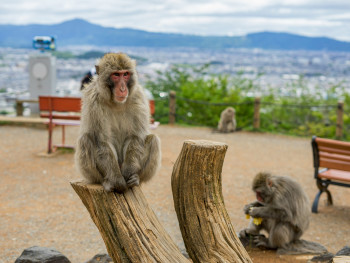
A family with children feeding Japanese macaques at Iwatayama Monkey Park in Kyoto, Image by Atanas Malamov on Unsplash. Japan.
The park is open year-round, and each season has its own character. Spring brings cherry blossoms in the valley. Summer means long days and city lights appearing at dusk. Autumn brings crisp air and fiery foliage, both on the mountain and in the cityscape below.
Beyond Arashiyama: Quiet Bamboo Groves
Bamboo groves throughout Kyoto city offer immersive natural experiences, though most tourists only visit the famous grove in Arashiyama. The Arashiyama bamboo grove is genuinely spectacular. Walking through it feels like entering a natural cathedral, where filtered sunlight creates constantly shifting patterns on the path. This bamboo forest represents one of Japan's most photographed natural settings, and for good reason.

A peaceful path winding through a bamboo grove with sunlight filtering softly through the leaves. Image by Inês Conceição on Unsplash.
But smaller bamboo groves scattered throughout Kyoto city provide similar experiences without the crowds. The grove near the Kyoto Botanical Gardens stays relatively quiet, even during peak tourist season. Another excellent bamboo forest sits near Kodai-ji temple, accessible via a walking path that also winds through traditional residential neighborhoods and offers glimpses of historic wooden houses.
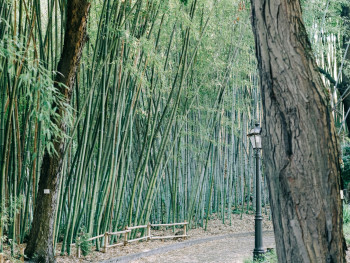
Quiet bamboo grove featuring a stone path and traditional wooden gate, away from Kyoto’s main tourist spots. Image by Gabriella Clare Marino on Unsplash.
These lesser-known bamboo groves offer opportunities to experience the acoustic properties that make bamboo forest environments so distinctive. The sound of wind through bamboo leaves creates a subtle rustling that is both calming and otherworldly. In quieter groves, you can also hear the percussion-like sounds of bamboo stems knocking against each other in the breeze. These natural rhythms inspired traditional Japanese music and poetry for centuries.
Bamboo forest paths connect to networks of hiking trails that stretch throughout the mountains surrounding Kyoto city. These trails offer perspectives on how bamboo groves fit into larger forest ecosystems and provide habitat for various wildlife species. The integration of bamboo forest areas with other plant communities illustrates the ecological principles that shaped traditional Japanese culture and continue to influence contemporary environmental practices.

A bamboo grove transitions into a mixed forest along a hiking trail in the mountains near Kyoto. Image by Robert Chen on Unsplash.
Cherry Blossoms Without the Crowds
Maruyama Park provides Kyoto's most accessible cherry blossom viewing, but it's worth visiting throughout the year. In autumn, the maple trees create color displays that rival the spring blossoms. Winter transforms the park into a peaceful space where you can appreciate the underlying landscape structure without seasonal distractions.
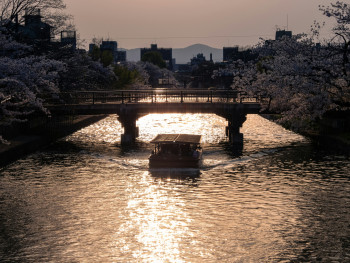
Cherry blossom trees lining a peaceful canal, glowing softly in the warm light of a Kyoto sunset. Image by Yanghong Yu on Unsplash.
The park's design integrates natural and constructed elements in ways that feel effortless but require constant maintenance. The paths follow natural contours while providing access to viewing areas positioned to optimize seasonal displays. Small bridges cross streams at points chosen to create the most pleasing sight lines. It’s landscape architecture at its most sophisticated, designed to enhance natural beauty rather than dominate it.
The Philosopher’s Path: Kyoto at Walking Speed
The Philosopher's Path provides one of Kyoto's most accessible walking experiences that combines natural beauty with cultural significance. This stone pathway follows a canal lined with cherry trees that create spectacular displays during cherry blossom season. Unlike crowded temple visits, the Philosopher's Path allows you to experience seasonal changes at your own pace while connecting several significant cultural sites.
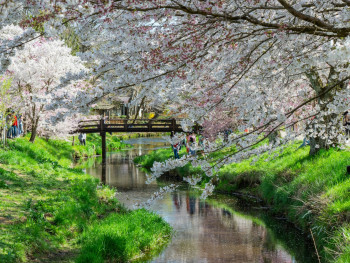
Canal along Kyoto’s Philosopher's Path lined with cherry trees bursting into full blossom during spring. Image by Maple Cloud on Unsplash.
The Philosopher's Path connects Ginkaku-ji temple (the Silver Pavilion) to the ancient temples of the Higashiyama district, but the walk itself offers value independent of its endpoints. The path demonstrates how Kyoto city integrates natural elements into urban planning, creating spaces where residents can experience seasonal changes without leaving the city.
Cherry trees along the Philosopher's Path represent one of Kyoto city's most reliable cherry blossom season experiences. The canal setting creates reflections that double the visual impact of the blossoms, while the walking path provides multiple viewpoints for photography and contemplation. During cherry blossom season, early morning visits offer the best combination of optimal lighting and minimal crowds.
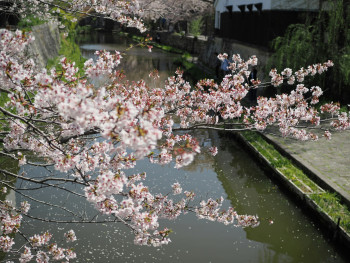
Delicate cherry blossom petals drifting on the calm water of the Philosopher's Path canal in Kyoto. Image by Kazuyuki Aoki on Unsplash.
Moss Gardens in Unexpected Places
Beautiful moss garden designs appear throughout Kyoto city, often in unexpected locations. While famous Zen Buddhist temple complexes like Kodai-ji temple contain spectacular moss gardens, smaller examples can be found in residential areas, hotel courtyards, and even shopping center atriums. These installations demonstrate how Japanese culture values natural beauty in everyday contexts.
Kyoto Botanical Gardens: Nature Through All Seasons
The Kyoto Botanical Gardens provide the most comprehensive seasonal experiences available in the city. Each season brings different highlights: spring bulbs and flowering trees, summer tropical displays and evening illuminations, autumn color changes throughout the deciduous collections, and winter's stark beauty in the evergreen sections.
The gardens' educational programming helps visitors understand the relationships between plants and human culture. Regular workshops cover topics like traditional Japanese gardening techniques, seasonal cooking with garden plants, and historical uses of various plant species.
17,500+ 5-Star Reviews and Counting
Trusted and recommended by travelers worldwide, including 99% on Google and TripAdvisor.
Planning Tip: Skip the Temple Fatigue
Avoiding Temple Fatigue with Smarter Itineraries
After watching thousands of visitors exhaust themselves trying to see every famous temple in a single trip, I’ve developed some strong opinions about itinerary planning. The most successful visits I’ve witnessed prioritize depth over breadth. They focus on understanding a few places thoroughly rather than ticking boxes at dozens of locations.
Temple fatigue is real, and it ruins more Kyoto visits than most people want to admit. After the third or fourth temple, they start blending together. The architectural details that seemed fascinating at first begin to feel repetitive. The historical significance that captivated you at the first sight can feel redundant by the fifth
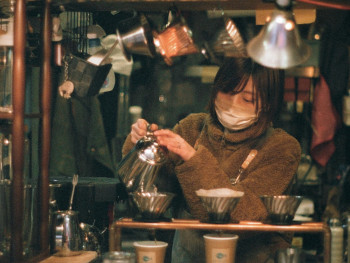
A Kyoto barista carefully prepares pour-over coffee in a cozy, traditional café setting. Image by Jasper Wilde on Unsplash.
Instead of hopping from temple to temple, I recommend balancing cultural sites with contemporary experiences. Spend a morning exploring one significant temple. Then in the afternoon, take a neighbourhood walk through independent shops, local cafés, and residential streets. This kind of itinerary gives historical sites more meaning and shows how traditional culture continues to evolve in daily life.
Where Cafe Culture Becomes Cultural Insight
Local cafes serve as perfect reset points during busy sightseeing days. A well-made cup of coffee in a thoughtfully designed space can restore your energy and perspective better than rushing to the next attraction on your list. Many Kyoto cafes occupy traditional buildings that show a different approach to architectural preservation than what you’ll find at major temples.
The cafe culture in Kyoto reflects broader Japanese aesthetics in ways that feel approachable. The attention to detail, seasonal awareness, and focus on creating perfect everyday experiences all tie back to principles you'll also find in more formal cultural settings. Recognizing these connections deepens your appreciation for everything else you’ll encounter across the city.
Where Cafe Culture Becomes Cultural Insight
Day trip planning should consider transportation time, crowd patterns, and energy levels. For detailed suggestions, see our things to do in Kyoto day trip guide, which offers specific routes that reduce backtracking and increase variety.
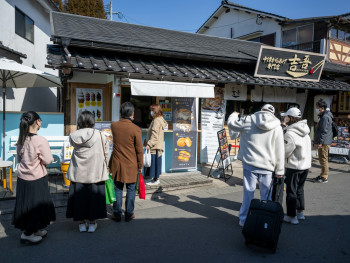
Visitors exploring Kyoto on a flexible, personalized itinerary beyond temples, soaking in local culture and scenes. Image by Kouji Tsuru on Unsplash.
The most satisfying Kyoto visits I've observed combine scheduled activities with unstructured exploration time. Plan your must-see destinations for specific time slots, but leave gaps in your schedule for spontaneous discoveries. The city rewards wandering, and some of its best experiences can't be booked in advance.
Seasonal timing affects everything in Kyoto, not just temple visits. Spring brings cherry blossoms but also huge crowds and premium pricing. Summer offers festivals and extended daylight hours but comes with intense heat and humidity. Autumn provides spectacular foliage and ideal weather, but also dense crowds. Winter delivers peaceful sightseeing conditions, though some outdoor activities may be limited.
Each season has its strengths if you plan accordingly. Spring visitors should book accommodations early and be ready for busy sites, but the city looks its most photogenic. Summer travelers can enjoy vibrant festivals and long evenings, though it's smart to include air-conditioned stops for midday breaks.
Fall visitors benefit from great weather and beautiful scenery, but they'll face peak prices and competition at popular spots. Winter travelers enjoy quieter streets, better value, and a more local rhythm as tourism slows down.
Or check our full range of Kyoto experiences here for curated activities that go beyond standard tourist attractions. Why Kyoto City Rewards Patient Exploration.
Ancient Sites, Modern Context
The difference between visiting temples as checklist items and experiencing Kyoto as a living place comes down to patience and curiosity. Ancient sites like Kinkaku-ji and Kiyomizu-dera deserve their reputations, but they represent single moments in a continuous cultural evolution that’s still unfolding.
Kyoto functions as both an ancient capital and a modern city. These roles occasionally conflict but more often complement each other. The UNESCO World Heritage Site locations preserve specific historical moments, while neighborhoods, markets, and daily practices show how traditional Japanese culture adapts to contemporary life.
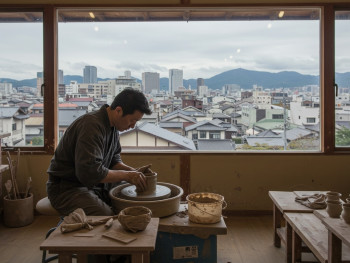
Artisan shaping pottery in a traditional workshop with a modern Kyoto cityscape visible through the window.
Tradition Adapted to Daily Life
When you explore Kyoto with attention to these continuities, rather than focusing solely on preserved sites, you discover a city that is both ancient and thoroughly modern. The geisha district still follows centuries-old traditions while adapting to current social and economic realities. Tea houses serve matcha using traditional methods, even as they meet modern health and safety standards.
Japanese culture today reflects this same blend of continuity and adaptation. The principles that shaped ancient Japan still influence aesthetic choices, business habits, and social customs. Understanding these links makes temple visits more meaningful because you see them as part of a living tradition, not as frozen relics of the past.
The Ongoing Influence of Zen Aesthetics
The oldest Zen temple complexes in Kyoto demonstrate architectural and philosophical principles that still appear in contemporary settings. Modern buildings across the city often borrow design elements first developed in Zen Buddhist temple construction. Today’s meditation practices also draw from Zen traditions, adapting techniques once used in monastic life for secular, everyday use.
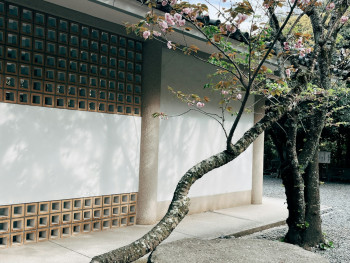
Contemporary building in Kyoto featuring clean lines and Zen-inspired architectural elements. Image by Natalie Leung on Unsplash.
Natural Beauty as Living Heritage
This integration of ancient and contemporary elements extends to natural spaces as well. The beautiful moss garden designs you'll see at Kodai-ji temple and other historic sites have inspired modern landscape architecture throughout Kyoto city. Even the cherry trees lining contemporary streets follow aesthetic principles rooted in temple gardens developed centuries ago.
Kyoto rewards travelers who appreciate both preservation and evolution. The city maintains its historical character while continuing to develop cultural practices that meet present-day needs. This balance helps ensure traditional Japanese culture stays vibrant and relevant, rather than fading into something static or purely ornamental.
Planning Your Non-Temple Kyoto Experience
Where Real Kyoto Comes Into View
When you visit Kyoto with a focus on experiences beyond temple tourism, you discover a city with layers that most guidebooks never mention. The capital contains a mix of culture, history, and everyday life that rewards patience and genuine curiosity.
Kyoto Prefecture offers countless destinations beyond the famous UNESCO World Heritage sites. Local markets like Nishiki Market give you immediate encounters with Japanese culture through food, crafts, and everyday interaction. Hidden gems like independent tea houses and neighborhood ji temples offer personal experiences without the crowds.
A City That Lives, Not Just Preserves
These experiences often provide deeper cultural understanding than traditional sightseeing because they show how historical principles continue to shape contemporary life. Instead of viewing culture as something preserved in museums and temples, you see it as a living force that continues to evolve and adapt.
Kyoto city's beauty isn't just in what's preserved, it's in what's lived. The city I call home extends far beyond its famous UNESCO World Heritage Site locations. It includes neighborhoods, traditions, and experiences that reveal themselves only to visitors willing to look beyond the obvious attractions.
Beyond the Temple Trail
When you skip the standard temple trail and explore Kyoto through local experiences, you discover a city that is both an ancient capital and a modern urban center. You find things to do in Kyoto that aren't temples but still connect you to the cultural principles that make this place unique. From monkey park adventures to bamboo forest walks, from tea ceremony experiences in contemporary tea houses to hidden gems scattered throughout central Kyoto, the alternatives offer depth and authenticity.
The monkey park views, manga museums, bamboo groves, and independent cafes I've shared aren't substitutes for Kyoto's famous temples. They're complementary experiences that give context and depth to your understanding of this complex city. Japanese culture appears just as clearly in a neighborhood Shinto shrine ceremony as it does in a UNESCO World Heritage Site temple, often with fewer crowds and more opportunities for real cultural connection.
Tradition Meets Everyday Life
When you visit Japan, and Kyoto city in particular, understanding both the preserved ancient temples and the living culture gives you the fullest experience. The Golden Pavilion and Silver Pavilion are historical icons worth seeing, but it’s the tea houses, local food markets, moss garden designs in modern spaces, and seasonal celebrations in Maruyama Park that show how traditional Japanese culture continues to evolve.
Central Kyoto offers both preserved landmarks and dynamic, lived-in culture. The geisha district maintains centuries-old customs while adapting to modern life. Nishiki Market serves tourists curious about Japanese food culture and locals buying dinner. Bamboo groves offer natural calm away from the city, while also reflecting ecological ideas that shaped Japanese design for generations.
What You’ll Take With You
Next time someone asks you about things to do in Kyoto besides temples, you'll have answers that go far beyond standard guidebook recommendations. You'll know where locals go to breathe, where contemporary culture intersects with traditional aesthetics, and how to experience Kyoto city as much more than the sum of its famous UNESCO World Heritage Site locations. You'll understand that Kyoto rewards curiosity, patience, and a willingness to explore beyond the obvious. Those are the qualities that make any visit here more meaningful and memorable.
Travel Kyoto Your Way
SEE KYOTO EXPERIENCESBeyond Temples: Discover Kyoto’s Real Heart
Skip the crowds and explore Kyoto’s hidden gems, local spots, and authentic experiences beyond the usual temple trail.
Plan Your Authentic Kyoto Experience
Book a free, no-pressure call with a local to explore hidden gems, food spots, and culture beyond the temples. Your trip, your way.
PLAN YOUR EXPERIENCE


